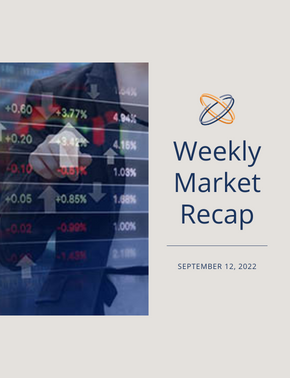Week in Review
Equity Markets:
The S&P bounced 4.1% after three consecutive negative weeks. The oversold environment contributed to the strong rally this past week. Pessimism dominated over the past three weeks following Chairman Powell’s comments at the Jackson Hole Symposium.
Rhetoric was a major driver of the most recent downturn and the market had reached a pivotal point where a further move down needed substance and was running out of steam on sentiment alone. It appeared the 3,900 level on the S&P was a key point the market was going to bounce off of or break through, but the downside needed a catalyst. A catalyst has yet to arrive for a further substantial breakdown in the markets.
Earnings season is essentially complete and the earnings growth for Q2 stood at ~6%. This number is below the original estimates of 9% starting the quarter, but much better than feared. The inflationary impacts and the first leg of rate hikes have begun to hurt corporate profits.
Fixed Income Markets:
Rates continued their march higher last week. The 10-year treasury ended the week at 3.31%, a steep climb from the 2.64% level seen in late July. The yield curve still remains deeply inverted and the 2’s/10’s spread currently sits at 0.41%.
Economic:
The ISM data from the services sector showed inflation pressures are easing to an extent. The Fed’s Beige Book also pointed to a similar picture regarding inflation.
On a global front, the European Central Bank increased rates by 0.75%. This was the largest rate hike in history for the ECB in response to the 9.1% inflation rate in the Eurozone. As the U.S. economy slows, we will be paying attention to the rest of the major economies in the world for potential spillover effects in the intertwined and globalized economy we have today.
Looking Ahead
Equity Markets:
Earnings revisions will be the focus going forward. Q3 earnings estimates currently stand at 3.7%, according to FactSet. This is lower than the estimates of 9.7% at the start of 2022. Headlines of recessionary fears have dominated, but a recession is not a foregone conclusion. An economic slowdown is likely to occur. This can be seen in earnings estimates. Inflation in the high single digits would have an impact at some point. It appears that pressure will be present over the next couple of quarters.
We expect continued volatility in the equity market while companies and sectors with stable financial positions will have the ability to withstand the choppy profit margin compression likely to come over the next three to six months. The unknowns leave investors in a position of uncertainty. This includes Fed policy, supply chain operations, and geopolitical events. Two of three are nearly impossible to predict, so we believe investors should take a calculated, diversified approach to the market. The catalyst for moves in either direction is building up, especially to the upside, but the lack of visibility does not make this environment one to take excessive risk. A systematic rebalancing strategy, coupled with an appropriate portfolio construction, can reap long-term benefits for disciplined investors.
Fixed Income Markets:
The CPI report has the potential to move the fixed income markets in a significant way. Our long-term rate call remains the same, the 10-year will bounce in the 3.25-3.5% range until the current cycle ends. On the heels of elevated inflation numbers over the past weeks, we see the 10-year rate having the potential to move in the 3.75% range, but not for a sustained timeframe. Inflation has remained longer than nearly all market analysts anticipated and this supports a slight shift in our potential upper end of the current rate cycle.
Economic:
Tuesday’s CPI report will be the headline report of the week. This has the potential to move the market in a significant manner before the FOMC meeting later this month. The market hopes for a continued cooling of inflation, which will likely lead to a more accommodative policy stance over the next three to six months. We will also see data from PPI and the import price index. The preliminary University of Michigan Consumer Sentiment Index is likely to garner heavy attention. The consumer makes up ~70% of the U.S. GDP, and a strong consumer lends itself to a strong economy.
Important Disclosures:
Investment Advisory Services offered through Krilogy®, an SEC Registered Investment Advisor. Please review all prospectuses and Krilogy’s Form ADV 2A carefully prior to investing. This is neither an offer to sell nor a solicitation of an offer to buy the securities described herein. An offering is made only by a prospectus to individuals who meet minimum suitability requirements.
All expressions of opinion are subject to change. This information is distributed for educational purposes only, and it is not to be construed as an offer, solicitation, recommendation, or endorsement of any particular security, products, or services. Diversification does not eliminate the risk of market loss. Investments involve risk and unless otherwise stated, are not guaranteed. Investors should understand the risks involved of owning investments, including interest rate risk, credit risk and market risk. Investment risks include loss of principal and fluctuating value. There is no guarantee an investing strategy will be successful. Past performance is not a guarantee of future results. Indices are not available for direct investment; therefore, their performance does not reflect the expenses associated with the management of an actual portfolio. The S&P data is provided by Standard & Poor’s Index Services Group.
Services and products offered through Krilogy® are not insured and may lose value. Be sure to first consult with a qualified financial advisor and/or tax professional before implementing any strategy discussed herein.




















